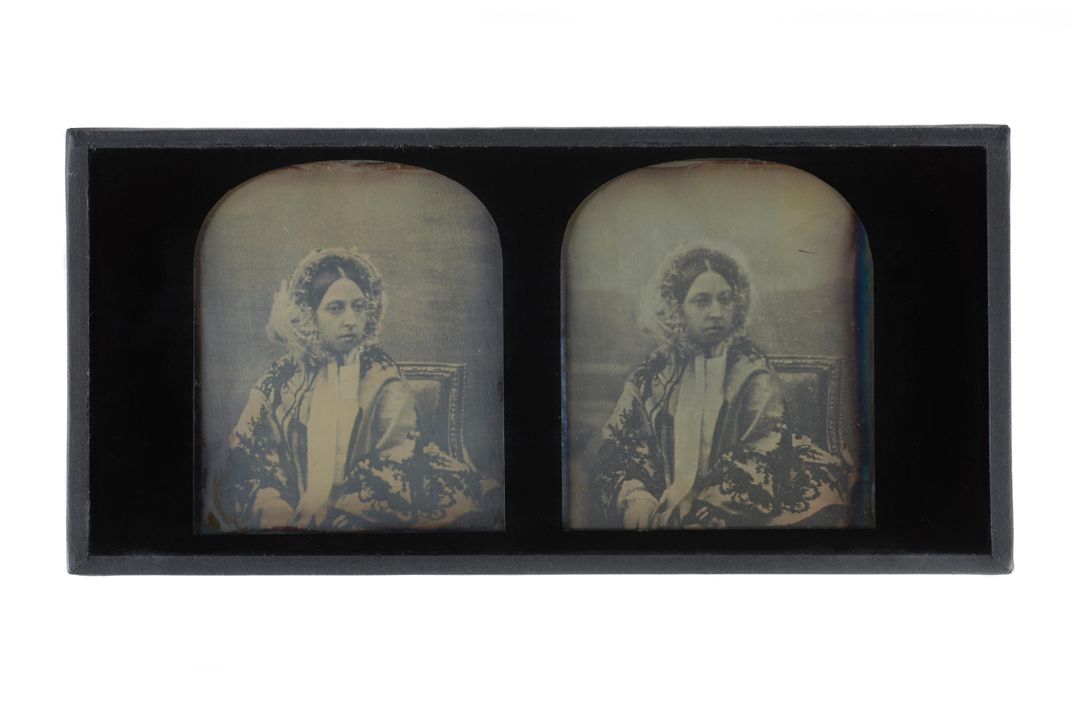Two Unseen Photographs of Queen Victoria Released in Honor of Her 200th Birthday
Victoria and her husband, Prince Albert, were early and eager adopters of new photographic technologies and commissioned many personal family portraits
/https://tf-cmsv2-smithsonianmag-media.s3.amazonaws.com/filer/cb/4c/cb4c5d8e-2191-4e0b-9ee6-cb967a2197d8/stereoscopic_portraits_of_queen_victoria_dated_1854__1___c_museum_of_london.jpg)
When photography began to flourish in the mid 19th century, it found enthusiastic proponents in Queen Victoria and her husband, Prince Albert. The royal couple collected photographs, developed their own images in a special dark room and commissioned photographers to take portraits of their family. In honor of the 200th anniversary of Victoria’s birth on May 24, the Museum of London recently provided the Observer with two of the monarch’s personal photographs, which have never before been seen by the public.
The images date to 1854, when Victoria was 34 years old. Taken by Antoine Claudet, a pioneering French photographer who established a daguerreotype studio in London, the photographs show the young queen face forward and in profile, wearing a luxurious dress and bonnet. These private images stand in stark relief to the more iconic portraits of Victoria, captured in the later years of her life, that conveyed an aura of majesty and imperialism to the public.
“It’s a younger, fresher, more fashionable queen,” Francis Marshall, a senior curator at the Museum of London, tells the Observer’s Rob Walker. “You wouldn’t think it’s Victoria.”
The newly released images are also noteworthy because they are rare examples of stereoscopic daguerreotypes: two identical images, taken by two cameras, which were placed side-by-side in a special viewing device that combined the images into a single, three-dimensional photograph. “You would put the goggles in front of your face and see the images blend together—and that created an illusion of three dimensionality,” Marshall explains.

Victoria and Albert were early adopters of a technology that captivated Britain during their reign. Photographs were on display at the Great Exhibition of 1851 in London, a display of design and manufacturing that was championed by Albert. Many in attendance had never seen such images before, according to the J. Paul Getty Museum, and photographic exhibitions and societies soon began cropping up across the country. The queen and her consort played a vital role in fueling the medium’s popularity; they visited photography displays, acted as patrons of the Photographic Society of London and purchased the works of various photographers from Britain and beyond.
For some years, the couple kept their personal photographs—images that bear witness to Victoria’s life as a mother and wife—private. But in 1860, Victoria agreed to have her own portrait and those of other royal family members issued as “cartes de visite,” small portraits that were exchanged on special occasions and pasted into albums. The royal family’s carte portraits sparked a craze for collecting celebrities’ images, which could be purchased at stationer’s shops. Years later, after selecting an official portrait for her Diamond Jubilee in 1897, the queen convinced photographers to give up their rights to the image so it could be publicly distributed. According to TIME’s Mia Tramz, the portrait appeared on “everything from tea towels to biscuit tins,” allowing Victoria to propagate an image of herself as the regal head of a powerful empire.
The queen was, in other words, keenly aware of photography’s power to both exalt the position of the monarchy and make it more accessible to the public—a lesson that Britain’s royal family continues to follow to this day.